- Lifetime Achievement Award for SRMAP Librarian September 1, 2025
Andhra Jyothi
Continue reading →
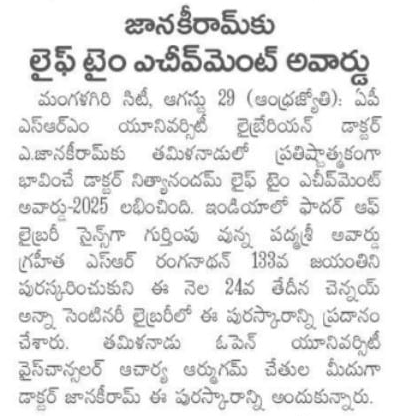
Andhra Prabha
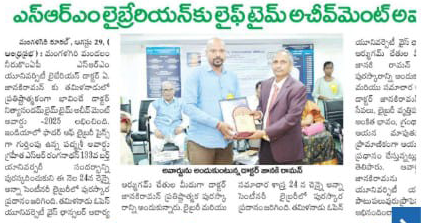
Vartha
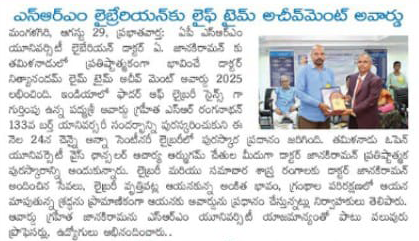
Andhra Patrika
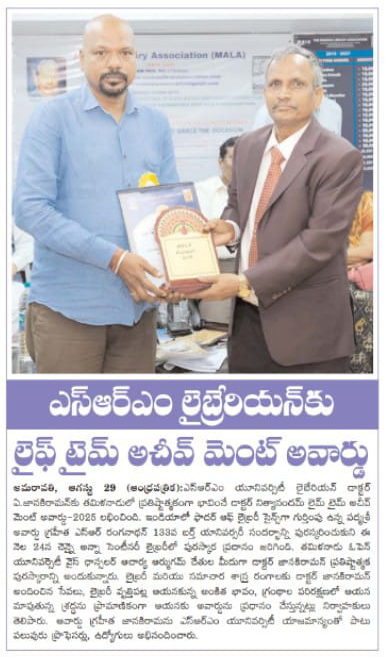
Disa
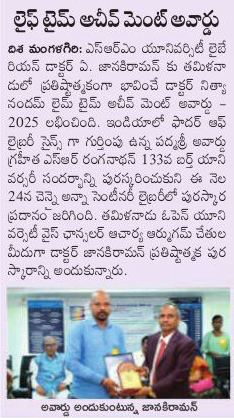
Journalist File
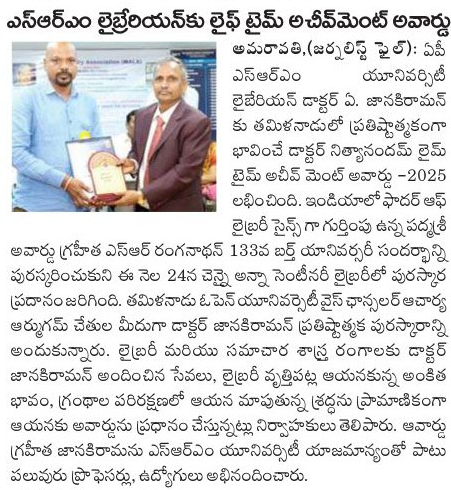
Kakateeya
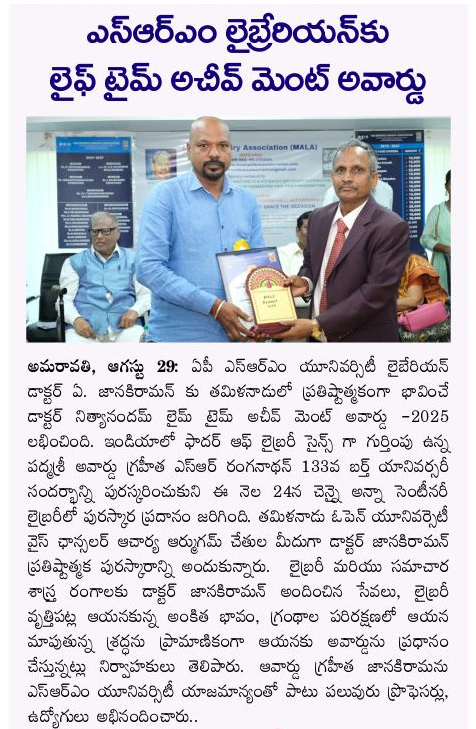
- National Educators’s Summits 2025 September 1, 2025
The Pink City witnessed an engaging exchange of ideas as SRM University-AP successfully hosted the National Educators Summit 2025 at Hotel Fern Ecotel, Tonk Road, Jaipur. The summit brought together leading school counsellors, coordinators, HODs, and principals from some of the most reputed schools to deliberate on the theme, “Liberal Arts and 21st Century Learning.”
The event was graced by Mr. Ashok Vaid, Principal of Maheshwari Public School and Chairman of Sahodaya Group of Institutions, as the Chief Guest. Prominent educators from institutions including JGPS, MPS, Dharav, Ryan International, SJ Public School, and Vivek Techno School actively participated in the discussions, underscoring the growing relevance of liberal arts in shaping holistic education.
SRM University-AP was represented by Prof. Vishnupad, Dean of the Easwari School of Liberal Arts, and Dr. Nishant K.S., Assistant Professor of Anthropology. Prof. Vishnupad shared insights on “Liberal Arts is not a Back-up Plan: Why the World Needs Humanities More Than Ever”, while Dr. Nishant led a thought-provoking session on “Defining and Understanding the Social Embeddedness of Technology.”
The summit witnessed dynamic panel discussions and brainstorming sessions where educators collectively emphasized that liberal arts education is not just relevant but essential in today’s fast-evolving academic and professional landscape. The deliberations highlighted how critical thinking, creativity, and interdisciplinary learning- the hallmarks of liberal arts- are key to preparing students for the challenges of the 21st century.
Speaking about the initiative, the organizers from SRM-AP reiterated the University’s commitment to extending its learning and vision to a wider student community across India. “This summit is a step toward reimagining education that nurtures both intellect and empathy. We look forward to hosting more such impactful engagements in the future,” they said.The evening concluded with a felicitation ceremony followed by a networking dinner, leaving participants inspired to integrate liberal arts perspectives into mainstream education.
Continue reading → - Dr Aswani on Blockchain-Based Self-Sovereign Identity Management August 31, 2025
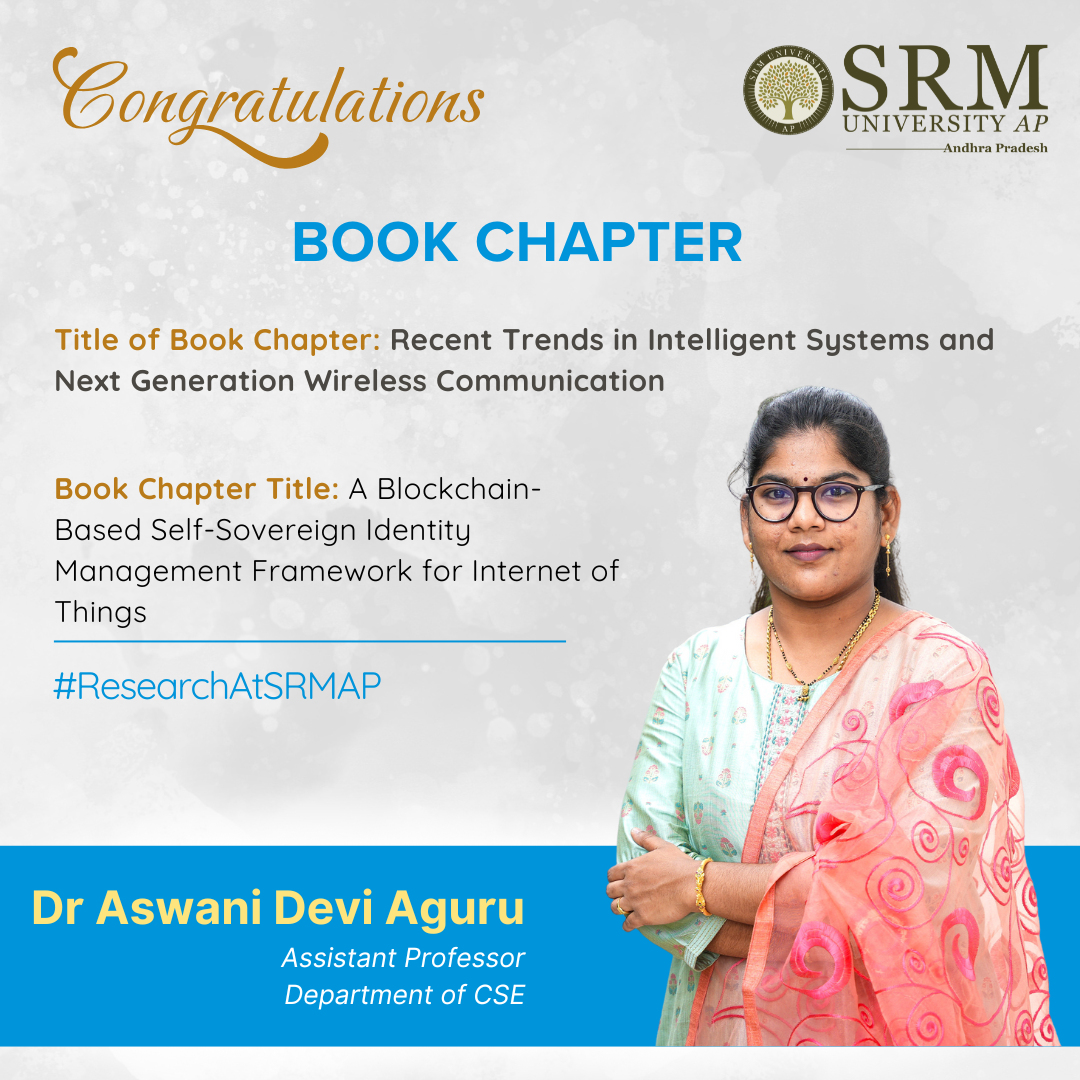 The book chapter “A Novel Blockchain-Based Self-Sovereign Identity Management System for IoT Devices” is a transformative exploration within the book “Decentralized Identity Systems: Innovations and Challenges.” Authored by Dr Aswani Devi Aguru, Assistant Professor, Department of CSEand co-authored by Dr Suresh Babu Erukala NIT Warangal, this chapter delves into the critical intersection of blockchain technology and identity management, specifically tailored for the rapidly evolving Internet of Things (IoT) landscape.
The book chapter “A Novel Blockchain-Based Self-Sovereign Identity Management System for IoT Devices” is a transformative exploration within the book “Decentralized Identity Systems: Innovations and Challenges.” Authored by Dr Aswani Devi Aguru, Assistant Professor, Department of CSEand co-authored by Dr Suresh Babu Erukala NIT Warangal, this chapter delves into the critical intersection of blockchain technology and identity management, specifically tailored for the rapidly evolving Internet of Things (IoT) landscape.Brief Introduction of the Book Chapter.
This book chapter presents a novel blockchain-based self-sovereign identity (SSI) management system that promotes global interoperability by generating decentralized, secure, and unique identifiers for edge devices worldwide. The proposed system leverages the power of permissioned Blockchain, specifically Hyperledger Indy, a distributed ledger technology (DLT) designed for creating and managing decentralized identities. The EdDSA-based key management and Plenum Byzantine Fault Tolerant (BFT)-based consensus algorithm introduce novelty and effectiveness in the proposed framework compared to state-of-the-art works on identity management. The performance of Hyperledger Indy Blockchain is tested on Hyperledger Caliper in terms of run time of operations and transaction throughput. We proclaim that our work is one of the earliest studies on Blockchain-based SSI management on Hyperledger Indy.
Significance of the Book Chapter
The author expresses strong enthusiasm for designing novel frameworks for IoT device authentication utilising ECC and AEAD primitives, in addition to developing identity management solutions based on SSI. The alignment of the book’s topics with current research highlights their significance in the progression of these critical areas.
Target Audience:
Very limited research has been carried out on SSI for IoT devices. Researchers will find the book chapter helpful in beginning their research on Blockchain-based decentralised identity management of IoT devices.
Co-authors or other Major Contributors
Dr Suresh Babu Erukala is a co-author. He is working as an Associate Professor in the Department of CSE at NIT Warangal.
- A Secure Framework for Embedding Secret Messages within Cover Images August 31, 2025
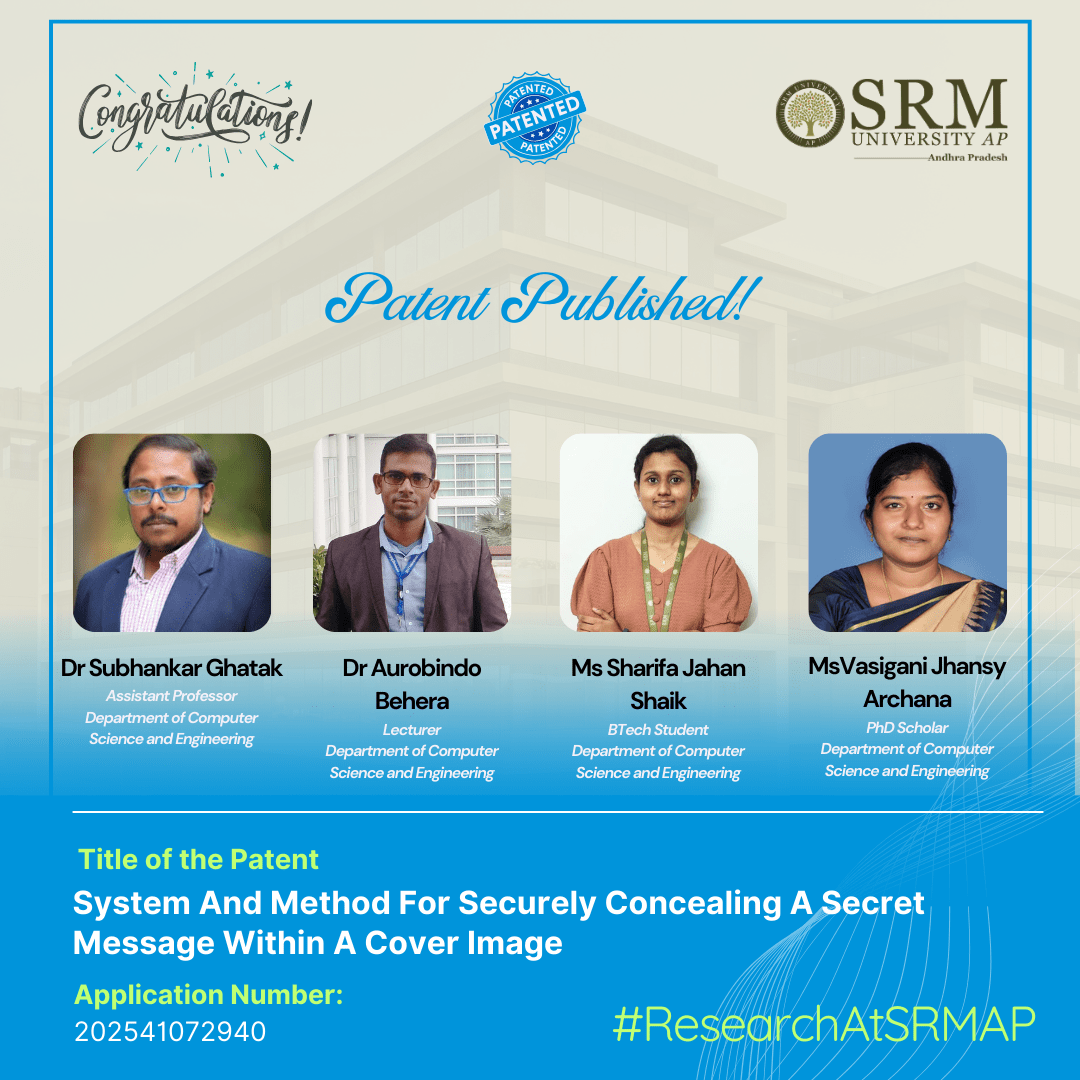 The Department of Computer Science and Engineering has filed and published a patent application titled “System and Method for Securely Concealing a Secret Message within a Cover Image” (Application No. 202541072940) in the Patent Office Journal. The invention is credited to Dr Subhankar Ghatak, Assistant Professor, Department of CSE, Dr Aurobindo Behera, Lecturer, Department of CSE (SRM Education), Ms Sharifa Jahan Shaik, U G Student, Department of CSE, and Ms Vasigani Jhansy Archana, Ph.D. Student, Department of CSE.
The Department of Computer Science and Engineering has filed and published a patent application titled “System and Method for Securely Concealing a Secret Message within a Cover Image” (Application No. 202541072940) in the Patent Office Journal. The invention is credited to Dr Subhankar Ghatak, Assistant Professor, Department of CSE, Dr Aurobindo Behera, Lecturer, Department of CSE (SRM Education), Ms Sharifa Jahan Shaik, U G Student, Department of CSE, and Ms Vasigani Jhansy Archana, Ph.D. Student, Department of CSE.This innovation introduces a new paradigm in data hiding, advancing beyond conventional steganography techniques. Unlike traditional methods that subtly alter a cover image to embed secret information, this approach leaves the image entirely untouched.
By leveraging Pseudo-Random Number Generation (PRNG) in combination with the cover image and securely storing the PRNG seed value on the Blockchain, the system achieves unparalleled data security and integrity. As a result, the cover image remains completely unmodified, ensuring minimal distortion and highly reliable message retrieval.
Abstract :
This invention presents a novel approach to data hiding that differs from conventional steganography techniques. Unlike traditional methods, which modify the cover image to embed secret data, this methodology ensures the cover image remains completely unaltered. The technique employs Pseudo-Random Number Generation (PRNG) in conjunction with an array and the cover image to conceal secret data. The PRNG seed value is securely stored on the Blockchain, thereby enhancing both uniqueness and security. Since the cover image undergoes no modification, the proposed approach achieves a minimal Mean Squared Error (MSE) for the extracted secret image.To hide a message in a picture, the usual way is to change the picture slightly—for example, by altering a few pixels so the difference is hard to notice. But if someone examines the image very closely, they might detect something unusual. Our method works differently. It’s like hiding a treasure without ever touching the map. Instead of altering it, we use a secret formula and a random number generator to decide where the hidden information would be if we needed to retrieve it later. The key to that formula is securely stored on the Blockchain, like locking it inside an unbreakable safe. As a result, the picture stays 100% original with no changes, and only the person who has the Blockchain secret key can uncover the hidden message.
Practical implementations :
Military Communication: Steganography can securely encode sensitive data, like that of meeting locations (latitude and longitude), ensuring that critical information remains hidden from adversaries.
Password Protection: Individuals can embed passwords within images, offering an additional layer of security and reducing the risk the unauthorized access.
Covert Communication: Activists or journalists in repressive regimes can use steganography to communicate securely by hiding messages within innocuous-looking images or files.
Medical Image Security: In healthcare, patient data can be securely embedded within medical images, ensuring data confidentiality while sharing the images with specialists.Future research plans:
AI-Assisted Stealth Optimisation: Use Machine Learning to predict detection patterns and further improve the undetectability of hidden data.
Cross-Platform Media Support: Extend beyond images to videos, audio streams, and 3D models, ensuring zero modification across formats.
Continue reading →
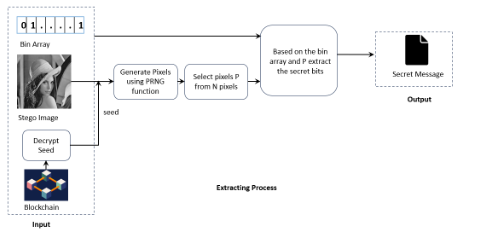
- Dr Barman on Hunting for heavy Z ′ August 31, 2025
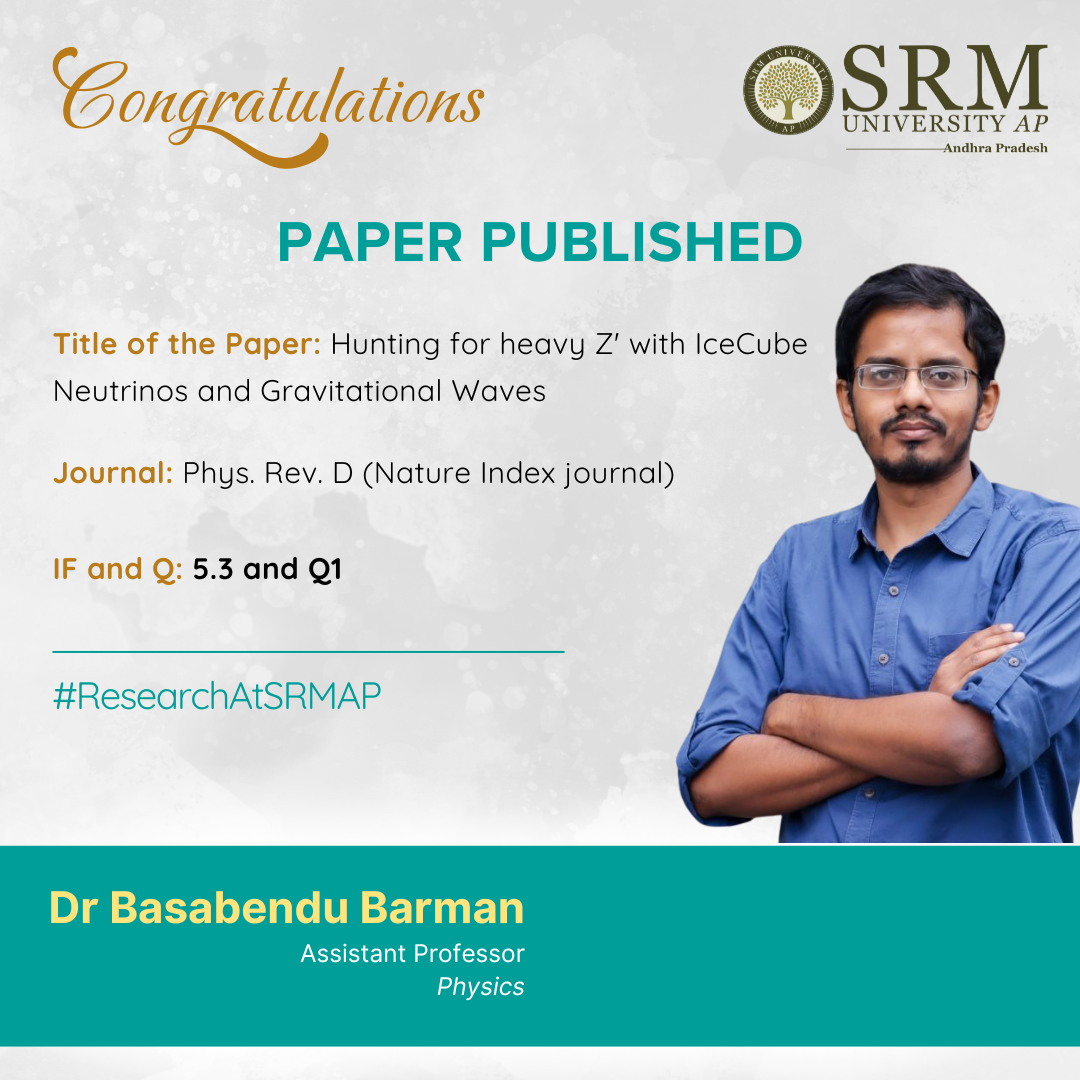 This research article, “Hunting for heavy Z ′ with IceCube neutrinos and gravitational waves,” by Assistant Professor Dr Basabendu Barma, explores the links between dark matter, the imbalance of matter and antimatter in the universe, and how these phenomena might be detected through various methods.
This research article, “Hunting for heavy Z ′ with IceCube neutrinos and gravitational waves,” by Assistant Professor Dr Basabendu Barma, explores the links between dark matter, the imbalance of matter and antimatter in the universe, and how these phenomena might be detected through various methods.Abstract:
In the minimal gauged B−L extension of the Standard Model, we demonstrate that PeV-scale dark matter (DM) and the baryon asymmetry of the Universe (BAU) can be simultaneously explained through the three right-handed neutrinos (RHNs) present in the theory. The DM candidate undergoes rare decay into light neutrinos, providing an explanation for the observed IceCube events, while the other two RHNs generate the BAU via leptogenesis. The breaking of gauge symmetry gives rise to detectable gravitational waves (GWs) from decaying cosmic strings (CS), making this framework testable at several future GW detectors—despite being beyond the reach of conventional collider experiments due to the extremely weak gauge coupling. The symmetry-breaking scale establishes a connection between particle masses, couplings, and the GW spectrum, offering a unified and predictive scenario.
From the Layman’s Perspective:
We know there are four fundamental forces in nature: strong, weak, electromagnetic, and gravitational. But what if there’s a hidden, fifth force we haven’t discovered yet? The Standard Model of particle physics, which organizes all known particles, doesn’t include this fifth force (and doesn’t include gravity either, unfortunately). So, how can we theoretically create a particle physics model for this possible fifth force? That’s what we explore in this paper.Interestingly, there are already experiments (for example, the Large Hadron Collider or LHC at CERN, Geneva) searching for signs of fifth forces. If this force exists, our model could be tested by these experiments. But there’s more! We also wanted to tackle a big mystery in cosmology: dark matter. Dark matter makes up about 24% of the universe, but we’ve never directly detected it because it doesn’t reflect light—it’s “dark.” However, there are smart ways to try to find it. In this paper, we propose how the same dark matter might interact with the visible universe through this fifth force and thereby leave their footrpints at IceCube experiment that looks for high energy neutrinos or at experiments that search for “spcaetime ripples” called the gravitational waves.
Practical Implementation & Social Impact:
This work primarily contributes to the realm of pure intellectual pursuit. Science speaks the language of data, and data is born from experiments. The validation of any well-constructed theory ultimately depends on experimental evidence. For this reason, it is essential for society to cultivate a culture that values fundamental scientific discussion and increases funding for basic research.
Collaborations:
This work has been done in collaboration with Arindam Das (Hokkaido U.), Suruj Jyoti Das (IBS, Daejeon, CTPU), Marco Merchand (Royal Inst. Tech., Stockholm and Stockholm U., OKC).
Future Plans:
A closer look into early universe dynamics by performing more involved simulations.
Connection between particle physics models and early Universe cosmology. Complementary searches from different experiments in unraveling new physics beyond the Standard Model. Searching new physics at energy and intensity frontier
Continue reading →

